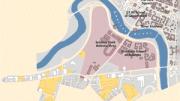From her office on the ninth floor of Holyoke Center, Kathy Spiegelman has a sweeping view southwest. She can look past the roof of Malkin Athletic Center and across the Charles to the campus of the Business School and the concrete bulk of Harvard Stadium. Just beyond, Boston's Allston neighborhood spreads along Western Avenue, mingling auto-body shops, warehouses, stores, and residences. The panorama seems fitting: since Spiegelman is Harvard's associate vice president for planning and real estate, her view is her work.
Until June 10, only Spiegelman and a very few others knew the thread that tied many of those diverse properties together. On that day, she notified the Boston Redevelopment Authority (BRA) that Harvard had acquired options to purchase 14 Allston parcels, totaling 52 acres, and was in the process of taking ownership (see "Make Way for Harvard," July-August, page 71).
The disclosure ended the opening act of what promises to be a long play--culminating, sometime in the next century, in the extension of Harvard's central campus southward.
The action began in the late 1980s, following the commercial building boom that swept all of Massachusetts, including Harvard Square, and engaged an array of developers, including the University itself, with such new properties as University Place, on Mount Auburn Street, and the Inn at Harvard. If Harvard continued growing along its traditional axes, says Sally Zeckhauser, vice president for administration, it would keep "butting up against residential neighborhoods." The University's Cambridge acquisitions in the 1960s included extensive residential holdings which then came under rent control. Under any conceivable future regulations, the buildings would be difficult to change to academic use, Zeckhauser says, "and rightly so," given problems of scale and traffic.
In effect, Harvard found itself progressively landlocked--a long-term problem for an institution that has, Spiegelman says, added 0ne million square feet of buildings per decade during this century. Contemplating the need to site future academic programs, new schools, expanded infrastructure, and social facilities (housing, day-care centers), the Corporation and administrators explored options for physical growth. They ranged from the Alewife area at the end of the subway line in northwest Cambridge, to Southborough, home to the libraries' remote depository. The latter, Zeckhauser says, "works well on books but it wasn't so clear it would work for University activities beyond storage."
 Initial public reaction to Harvard's land purchases was critical--as this Boston Globe editorial cartoon made clear. But some Allston residents welcomed the new owner. REPRINTED COURTESY OF THE BOSTON GLOBE
Initial public reaction to Harvard's land purchases was critical--as this Boston Globe editorial cartoon made clear. But some Allston residents welcomed the new owner. REPRINTED COURTESY OF THE BOSTON GLOBE |
And so the focus narrowed to Allston, the northern edge of which contains few residences and a mixture of changing commercial uses, including some large vacated warehouses and industrial parcels. Beginning in 1988, Harvard started to "buy what we could, without impinging on residential neighborhoods, in areas that were underutilized," Zeckhauser says. To "ensure that the University paid the fair market value," Spiegelman told the BRA, the buying and subsequent property management were conducted by the Beal Companies, acting on Harvard's behalf. That is, the University used a nominee to avoid paying the premium prices sellers often seek when the purchaser is either an institution or a buyer intent on assembling a group of properties (both factors applied here). It was the result of this arrangement, totaling Harvard's investment of $88 million in Allston properties, that Spiegelman reported to the BRA.
Immediately, a war of words broke out. Boston mayor Thomas M. Menino blasted Harvard's "total arrogance"--a sentiment echoed in a Boston Globe editorial cartoon depicting Harvard as a snake devouring Allston--and demanded that the University compensate the city by increasing scholarship funds for Boston residents. Thomas N. O'Brien, director of the BRA, worried aloud about the loss of property-tax revenues, and told the Globe of his concern over "negative impact on a close-knit residential neighborhood." Warren Tolman, a state senator who represents the area, weighed in with perhaps the best comment, echoed in a subsequent Globe cartoon, when he observed, "They're buying so many auto-body shops, I thought they might want to start a vocational school at Harvard."
The criticism was heightened by the timing and nature of Harvard's disclosure. The timing reflects the business school's pending revision and updating of its campus master plan, including construction of several new buildings over the next decade (see "Building Business," March-April, page 68). Some observers felt that the Allston land acquisitions should have been from the outset part of any adjacent University master plan--the zoning procedure designed explicitly to protect Boston neighborhoods from intruding institutions. In fact, says assistant dean Angela Crispi, business school officials had no inkling of the land purchases, and intend no changes in the proposed construction now that they know Harvard is one of the principal landlords across Western Avenue.
Moreover, it was difficult for critics to believe that Harvard had spent $88 million without having any concrete plans for the properties' future use. But in fact, this appears to be a clear case of banking land for needs to be determined in the future. Spiegelman says she has no idea how much building the properties could accommodate if they were rezoned to institutional use. Any physical planning, she explains, "starts in the individual schools, with the academic and campaign planning." And Zeckhauser notes that the current $2.1 billion University Campaign makes no provision for new facilities in the areas acquired.
In retrospect, University officials say, the intensity of the initial reaction didn't surprise them. Kevin McCluskey, Harvard's director of community relations for Boston, "anticipated there would be this sort of shock and the reaction that people had been deceived to some extent." As Spiegelman sees it, from the local perspective, residents feel powerless in the face of decisions by big institutions, "and that's a lousy feeling. I really do understand." Those sensitivities are particularly pronounced in the Allston-Brighton triangle, because the communities are bounded by Harvard to the north and Boston University and Boston College to the east and west, respectively.
Beyond those institutions, the neighborhoods have been "eminent-domained to death over the past 100 years" by the Massachusetts Turnpike Authority, railroads, and other significant property users, according to lifelong Allston resident Ray Mellone.
As passions cool--the mayoral rhetoric toned down considerably after Menino had a private meeting with Harvard president Neil L. Rudenstine--the perspective of Mellone and his neighbors will likely come to the fore in determining what becomes of Harvard's new landholdings. Mellone, a retired Boston city official who has been deeply involved in local zoning issues, chairs the dozen-member community task force that advises the BRA on the effects of institutional development and negotiates to "mitigate the impacts." Although he notes about Harvard's purchases that "Their decisions were made behind closed doors, and the public has been asked to react to them," Mellone says, "I'm not going to say Harvard's an evil empire." If the University's acquisition program was "deception, everybody's practiced it."
Instead, Mellone sees in the change in ownership of the Harvard parcels the seeds of opportunity. He notes, "It still is not possible for the University to make any use of the property for anything but commercial uses"--a point Spiegelman readily concedes. Looking around Western Avenue, he sees "chaotic" uses: "too many automotive businesses, poorly designed parking lots, bad frontages," and conflicts between residences and businesses. With Harvard publicly committed to investing in the community--as it did in upgrading a local shopping plaza, which Mellone calls a "shining example of the way big bucks can make a difference in the neighborhood"--he sees "an opportunity we'll never have again to improve this area." In the meantime, he voices no objections to the business school's revised plan for its present campus.
The payoff for the University, of course, is community support for its ultimate development plans. "It is my hope," says Spiegelman, "that by sharing this information, by the time Harvard develops uses for these parcels, we can have a plan that the community understands and believes in."
What might those plans be? On that subject, no Harvard official will even speculate. The issues go beyond community sensitivity, to the most political subject of all: who goes where. But it is possible to discern the kinds of big-picture ideas circulating now, some of which might take physical form in the Harvard of the next century: relocating administrative offices to accommodate academic growth in Cambridge; expanded housing, perhaps for the executive-education programs Rudenstine has been discussing; new space for the hemmed-in Graduate School of Education; or even a new complex to showcase the public treasures, and preserve the scholarly back-office collections, of the present science museums.
None of that appears likely before the "successor campaign," as Zeckhauser puts it--and with the University Campaign still nearly two years from completion, Harvard's Allston presence will not finally be determined until well into the future. But even as the University thinks in terms of decades, Mellone says, its new Allston neighbors will be pushing Harvard to make their community a more livable place today.






